
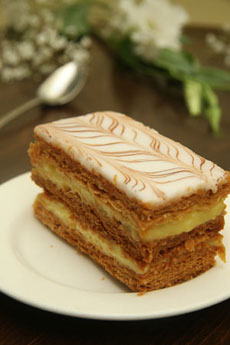 A Napoleon—named not after the emperor but after the city of Naples. The pastry is a type of mille-feuille. Photo courtesy FinancierPastries.com. A Napoleon—named not after the emperor but after the city of Naples. The pastry is a type of mille-feuille. Photo courtesy FinancierPastries.com.
June 2009
Last Updated February 2025
|
 |
Pastry Glossary: Different Type Of Pastry
Mille-Feuille & Other Types Of Pastry & Pies
Page 6: Definitions M ~ O
This page contains different type(s) of pastries such as mille-feuille, Mississippi Mud Pie, and Napoleon. This is Page 6 of a ten-page glossary. Click the black link below to visit other pages. See many other food glossaries, each featuring a different favorite food.
MACAROON
A small round cookie with a crisp crust and a soft interior. The original version was made in Italy from almonds and was evolved by French pastry chefs into an almond-flavored meringue sandwich cookie that today is made in many flavors and colors. A coconut macaroon was developed and is popular in the U.S. See the history of macaroons.
MARJOLAINE
A long and rectangular form of the dacquoise: almond and hazelnut meringue layers with chocolate buttercream. Dacquoise is a dessert cake made with layers of almond and hazelnut meringue and whipped cream or buttercream. It takes its name from the feminine form of the French word dacquois, meaning “of Dax”; Dax is a town in southwestern France. It is usually served chilled and accompanied by fruit.
|
|
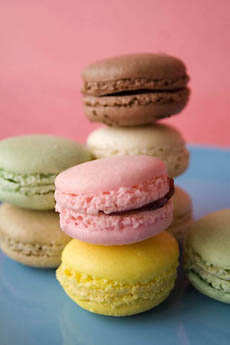
Macaroons from Mad Mac, a NIBBLE Top Pick of the Week. Photo by Claire Freierman | THE NIBBLE. |
MARZIPAN
See almond paste.
MEAT PIE
A meat pie is a savory pie that can be filled with beef, lamb, pork, poultry, and even fish, plus vegetables and herbs. There are many kinds of meat pies, varying in size and pastry types. They can be made in a pie plate or a square or rectangular baking pan. A pot pie is an example of a meat pie, as is a steak and kidney pie, and a shepherd’s pie, which is minced or ground beef or lamb with a top “crust” of mashed potatoes. Individual meat pies, which are sealed on all sides, include, among others, empanadas, pasties, Scotch pies, and turnovers. Meat pies date back to ancient times; they were a way to pull scraps together for a frugal dinner, while cooks in wealthier households prepared elaborate pastries filled with costly cuts.
|
|
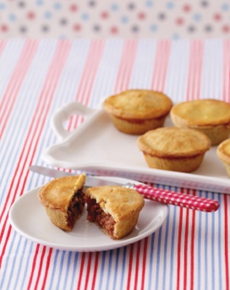
Mini meat pies. Photo courtesy The Gluten Free Cookbook. |
Savory pies could include fruits as well as meats, along with spices, wine, fat, and mincemeat. Later, in England, chicken and veal pot pie were sometimes cooked with mashed potatoes and a rich sauce filling, a precursor of shepherd’s pie; on the coast, fish and seafood pies prevailed). See pie.
MERINGUE
Meringue is a versatile substance made from beaten egg whites, to which sugar has been added to form stiff but airy peaks. The meringue can then (1) be folded in to lighten cake, mousse, and pastry cream, (2) used as a topping for pies (e.g., lemon meringue pie) and other desserts (e.g. Baked Alaska), (3) baked in a very low oven into cookies or cake layers, (4) baked into shells (vacherin) which are filled with custard, fruit, mousse or ice cream (see dacquoise).
|
|
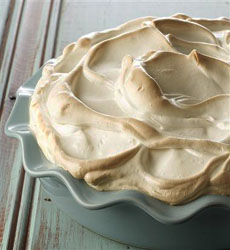
Lemon meringue pie. Photo courtesy McCormick’s. Find this and other delicious recipes at McCormick.com. |
MERVEILLEUX
Pronounced mair-vay-YUH, the word means “marvelous” in French. This pastry appeared in northern France after the Revolution, at the end of the 18th century. Meringues were topped with whipped cream and shaved chocolate. The modern French pâtissier Frédéric Vaucamps is credited with bringing back largely forgotten pastry in 1985. He reworked the recipe to make it lighter and created a variety of flavors. He named his business Aux Merveilleux de Fred.
|
|
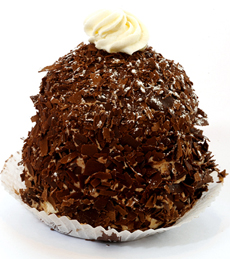
A Merveilleux in the original flavor, chocolate. Photo courtesy Aux Merveilleux de Fred. |
MILLE-FEUILLE or MILLEFOGLIE
Pronounced meal-FWEE in French and MEE-lay FOAL-yay in Italian, meaning “a thousand leaves,” this pastry is made as three rectangular sheets of puff pastry spread with Bavarian cream, pastry cream, whipped cream, custard, jam, or fruit purée, often dusted with confectioner’s sugar. It’s typically cut into individual rectangular portions and can be iced with fondant (see the (see photo below). The difference between mille-feuille and a Napoleon is that the latter is filled with almond cream. Savory versions are filled with cheese and served as appetizers. See also phyllo.
|
|
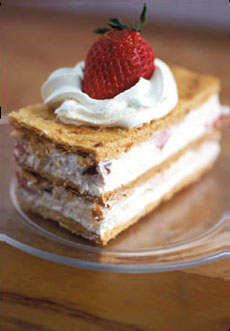
Millefoglie available from Venieros.com. |
MINCE PIE or MINCEMEAT PIE
Mince pie dates back to Medieval times, when the recipe included venison, along with dried fruits, sugar, and spices. It was then known as mincemeat pie. In the mid-nineteenth century, the meat began disappearing from the recipe, which evolved into the sweet and spicy mince pie we know today, served during the Christmas season, filled with candied and fresh fruits, nuts, sugar, spices, wine, and suet. (Suet is raw beef fat [or mutton fat], particularly the hard fat found around the loins and kidneys. Vegetarian suet is made from palm oil and rice flour.)
|
|
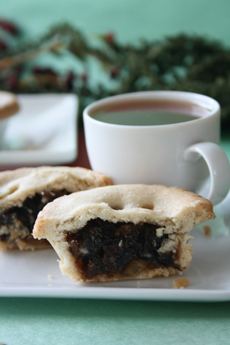
Mini mince pies. Photo by Hannah Kaminsky | THE NIBBLE. |
MISSISSIPPI MUD PIE or MUD PIE
An open pie consisting of a cooked chocolate filling in a crust made of chocolate or vanilla cookies or graham crackers. It is often topped with whipped cream and an optional garnish of chopped pecans. Some versions are made with coffee mousse or other coffee filling and a chocolate fudge sauce for the “mud.”
MOCK APPLE PIE
Mock pies developed as far back as the Civil War when war limited access to fresh fruit. The earliest recipe we have is from the Confederate Receipt Book of 1863. To ”mock the apples, soda crackers were soaked in water and mixed with sugar, lemon juice, and zest. This filling was baked in a pie shell. In 1935, Nabisco printed it on the box of Ritz Crackers, and the revival was an immediate hit.
|
|
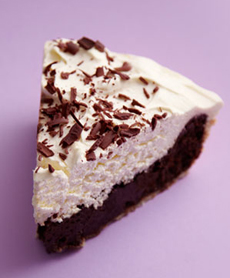
A chocolate pie often topped with whipped cream and chocolate shavings or chopped pecans. Photo courtesy Hummingbird Bakery. |
NAPOLEON
The Napoleon pastry was not named after France’s famous general and emperor. The name is believed to be a corruption of the word “napolitain,” referring to a pastry made in the tradition of Naples, Italy (napolitano). This pastry originated as a millefoglie, or mille-feuille, using a leaf-thin pastry most likely a descendant of phyllo. It is believed that the Napoleon and mille-feuille pastries were developed by the great chef Marie-Antoine Carême. Three layers of puff pastry (pâte feuilletée) are filled with almond cream and iced with fondant. In contrast the mille-feuille (above) is filled with vanilla pastry cream or custard.
- An “American Napoleon” has a heavily marbleized chocolate and vanilla fondant top, looking more like Jackson Pollack than the neat French style shown at the top of the page.
- An “Italian Napoleon” adds layers of rum-soaked sponge cake. Some variations layer fruit, such as raspberries, in the pastry cream.
|
|
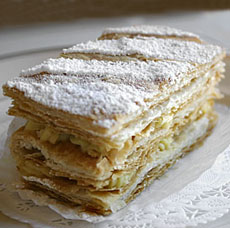
A Napoleon topped with confectioners’ sugar instead of fondant. Photo courtesy CafeBlanc.us.

An fondant-iced Napoleon (photo © Alina Matveycheva | Pexels). |
NESSELRODE PIE
Nesselrode pie is a classic Bavarian cream pie (i.e., a custard with added gelatin for stability and egg whites for volume and lightness), flavored with candied chestnuts and rum. It is named after Count Karl von Nesselrode, a 19th-century Russian diplomat who negotiated the Treaty of Paris after the Crimean War. The recipe began as Nesselrode pudding, a pink custard pudding enhanced with chestnut purée and maraschino cherry liqueur, plus maraschino-soaked fruits (candied lemon peel, currants, and raisins, whipped cream, and stiffly beaten egg whites. The original Nesselrode was chilled in a pineapple shape and is said to have been created for the count by his chef, a Monsieur Mouy, Mony, or Monie.
As a pie, Nesselrode was popularized by Hortense Spier, who had a brownstone restaurant in New York City on 94th Street between Columbus Avenue and Central Park West in the 1930s and 1940s. The restaurant closed before World War II; thereafter, Mrs. Spier baked pies for other restaurants (Nesselrode pie as well as banana cream pie, coconut custard pie, and lemon meringue pie). These pies became standards at New York restaurants.
A product called “Nesselro,” made by G.B. Raffetto, was used by home bakers through the 1970s but was discontinued when the pie went out of style. Containing candied chestnuts and fruits, it’s not difficult to recreate.
|
|
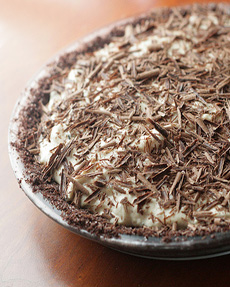
Nesselrode pie. Photo courtesy Savour Fare [since closed]. |
NOCCIOLA TART
An Italian tart with chocolate hazelnut filling, topped with chopped hazelnuts. Nocciola is the Italian word for hazelnut.
NUT PASTRY or NUT CRUST
This is plain pastry where 1/2 cup of finely ground nuts is substituted for 1/2 cup of flour. Ideal with cream pies. Here’s a recipe courtesy of the American Egg Board. Ingredients: 1 cup all-purpose flour, 1/2 cup (2 ounces) ground pecans or other nuts (such as almonds, hazelnuts, or walnuts), 1/2 teaspoon salt, 1/2 cup vegetable shortening (cold), 1 egg yolk, 3 to 4 tablespoon ice water, (divided), 2 teaspoons fresh lemon juice. Preparation: (1) Mix flour, nuts, and salt in a large bowl. (2) Cut in the shortening with a pastry blender until pieces are the size of small peas. (3) Mix in egg yolk, 3 tablespoons of ice water, and the lemon juice in a small bowl. |
|
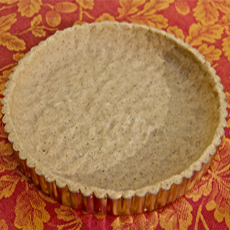
A tart crust made with ground pecans. Photo courtesy PaleoSpirit.com. |
(4) Add to flour mixture, 1 tablespoon at a time, stirring lightly and tossing with a fork until moistened and the dough just holds together. (5) Add remaining ice water, if needed. (6) Gather dough and shape it into a 1-inch thick disk. Refrigerate, wrapped in plastic wrap, 1 hour or overnight. (7) Heat oven to 425°F. Roll out dough on a lightly floured surface, rolling from center to edge, to form a 12-inch circle. (8) Fold into quarters; ease and unfold into a 9-inch pie plate. (9) Press pastry gently against the bottom and sides of the pie plate, easing out any air. Trim the edge leaving a 1/2-inch overhang. Fold overhang under; flute edge. (10) Refrigerate, covered, at least 30 minutes. (11) Line piecrust with aluminum foil; fill with pie weights. Bake in 425°F oven until pastry is set, 8 to 10 minutes. (12) Remove foil and weights; pierce pastry all over with a fork. Bake until pastry is golden brown, 5 to 7 minutes longer. Cool completely on a wire rack.
OPEN PIE
A single-crust pie, i.e., one with no pastry covering or other top crust.
Continue To Next Page: Terms With Pa
Go To The Article Index Above

|















